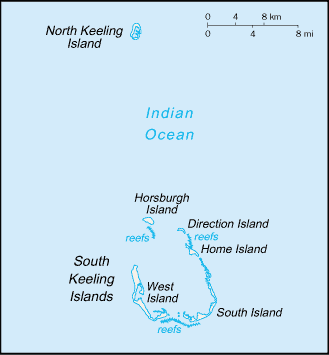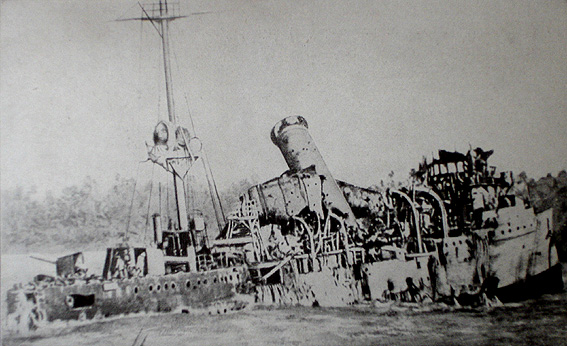North Keeling on:
[Wikipedia]
[Google]
[Amazon]

 North Keeling is a small, uninhabited coral atoll, approximately in area, about north of Horsburgh Island. It is the northernmost atoll and island of the Australian territory of the
North Keeling is a small, uninhabited coral atoll, approximately in area, about north of Horsburgh Island. It is the northernmost atoll and island of the Australian territory of the
 On 9 November 1914, the German cruiser attacked a wireless and cable station at Direction Island, attracting the attention of Australian cruiser . At 11:20, after an hour-and-a-half-long battle, the heavily damaged ''Emden'' was beached on North Keeling Island. In 1915, a Japanese company proposed that the ship be repaired and refloated, but an inspection by concluded that wave damage to ''Emden'' made such an operation unfeasible. By 1919, there were reports that the wreck had almost completely broken up and disappeared.
On 9 November 1914, the German cruiser attacked a wireless and cable station at Direction Island, attracting the attention of Australian cruiser . At 11:20, after an hour-and-a-half-long battle, the heavily damaged ''Emden'' was beached on North Keeling Island. In 1915, a Japanese company proposed that the ship be repaired and refloated, but an inspection by concluded that wave damage to ''Emden'' made such an operation unfeasible. By 1919, there were reports that the wreck had almost completely broken up and disappeared.
Pulu Keeling National Park
{{coord, 11, 50, S, 96, 49, E, type:waterbody_region:AU, display=title Islands of the Cocos (Keeling) Islands Ramsar sites in Australia 1995 establishments in Australia Important Bird Areas of Australian External Territories Uninhabited islands of Australia Important Bird Areas of Indian Ocean islands

Cocos (Keeling) Islands
)
, anthem = "''Advance Australia Fair''"
, song_type =
, song =
, image_map = Australia on the globe (Cocos (Keeling) Islands special) (Southeast Asia centered).svg
, map_alt = Location of the Cocos (Keeling) Islands
, map_caption = ...
. It consists of just one C-shaped island, a nearly closed atoll ring with a small opening into the lagoon, about wide, on the east side. The lagoon is about in area. The island is home to the only surviving population of the endemic, and endangered, Cocos buff-banded rail
The Cocos buff-banded rail, ''Gallirallus philippensis andrewsi'', is an endangered subspecies of the buff-banded rail endemic to the Cocos (Keeling) Islands, an Australian Offshore Territory in the central-eastern Indian Ocean.Commonwealth of Au ...
, as well as large breeding colonies of seabird
Seabirds (also known as marine birds) are birds that are adapted to life within the marine environment. While seabirds vary greatly in lifestyle, behaviour and physiology, they often exhibit striking convergent evolution, as the same enviro ...
s. Since 1995, North Keeling Island and the surrounding sea to from shore have been within the Pulu Keeling National Park.
History
The Cocos (Keeling) Islands are believed to have first been seen by Europeans in 1609 by CaptainWilliam Keeling
Captain William Keeling (1577 – 19 September 1619), of the East India Company, was a British sea captain. He commanded the ''Susanna'' on the second East India Company voyage in 1604. During this voyage his crew was reduced to fourteen men and ...
, after whom they are named, of the East India Company
The East India Company (EIC) was an English, and later British, joint-stock company founded in 1600 and dissolved in 1874. It was formed to trade in the Indian Ocean region, initially with the East Indies (the Indian subcontinent and South ...
on a journey from Java
Java (; id, Jawa, ; jv, ꦗꦮ; su, ) is one of the Greater Sunda Islands in Indonesia. It is bordered by the Indian Ocean to the south and the Java Sea to the north. With a population of 151.6 million people, Java is the world's mos ...
in the Dutch East Indies. North Keeling was sketched by Ekeberg, a Swedish captain, in 1749, showing the presence of coconut palm
The coconut tree (''Cocos nucifera'') is a member of the palm tree family (Arecaceae) and the only living species of the genus ''Cocos''. The term "coconut" (or the archaic "cocoanut") can refer to the whole coconut palm, the seed, or t ...
s. It also appears on a 1789 chart produced by British hydrographer Alexander Dalrymple
Alexander Dalrymple FRS (24 July 1737 – 19 June 1808) was a Scottish geographer and the first Hydrographer of the British Admiralty. He was the main proponent of the theory that there existed a vast undiscovered continent in the South P ...
.
North Keeling was visited in 1836 by Captain Robert FitzRoy
Vice-Admiral Robert FitzRoy (5 July 1805 – 30 April 1865) was an English officer of the Royal Navy and a scientist. He achieved lasting fame as the captain of during Charles Darwin's famous voyage, FitzRoy's second expedition to Tierra de ...
and his companion Charles Darwin
Charles Robert Darwin ( ; 12 February 1809 – 19 April 1882) was an English naturalist, geologist, and biologist, widely known for his contributions to evolutionary biology. His proposition that all species of life have descended ...
in , who was, as with many other visitors, unable to land on the island.
In the 19th century many people suffering from Beriberi
Thiamine deficiency is a medical condition of low levels of thiamine (Vitamin B1). A severe and chronic form is known as beriberi. The two main types in adults are wet beriberi and dry beriberi. Wet beriberi affects the cardiovascular system, ...
were put ashore at the island. Several graves are present, some from these people, but also from shipwrecks.
Battle of Cocos
 On 9 November 1914, the German cruiser attacked a wireless and cable station at Direction Island, attracting the attention of Australian cruiser . At 11:20, after an hour-and-a-half-long battle, the heavily damaged ''Emden'' was beached on North Keeling Island. In 1915, a Japanese company proposed that the ship be repaired and refloated, but an inspection by concluded that wave damage to ''Emden'' made such an operation unfeasible. By 1919, there were reports that the wreck had almost completely broken up and disappeared.
On 9 November 1914, the German cruiser attacked a wireless and cable station at Direction Island, attracting the attention of Australian cruiser . At 11:20, after an hour-and-a-half-long battle, the heavily damaged ''Emden'' was beached on North Keeling Island. In 1915, a Japanese company proposed that the ship be repaired and refloated, but an inspection by concluded that wave damage to ''Emden'' made such an operation unfeasible. By 1919, there were reports that the wreck had almost completely broken up and disappeared.
Seabird hunting
Between the First and Second World Wars, groups of about 20Cocos Malays
Cocos Malays are a community that form the predominant group of the Cocos (Keeling) Islands, which is now a part of Australia. Today, most of the Cocos Malay can be found in the eastern coast of Sabah, Malaysia, because of diaspora originatin ...
were stationed on the island for up to a fortnight at a time to harvest timber, coconuts and birds to take back to Home Island
Home Island, also known locally as Pulu Selma, is one of only two permanently inhabited islands of the 26 islands of the Southern Atoll of the Cocos (Keeling) Islands, an Australian external territory in the central-eastern Indian Ocean.
Des ...
. In the 1970s and 1980s, the acquisition of more efficient boats and firearms led to an increase in seabird hunting and concern about its impact on the seabird breeding colonies.
Pulu Keeling National Park
In 1986, an agreement was reached between the Australian National Parks and Wildlife Service and the Cocos Malay people to restrict and sustainably manage any further hunting on North Keeling. In 1989Cyclone John
Severe Tropical Cyclone John was an intense tropical cyclone that rapidly deepened offshore before devastating areas of Western Australia. The system was the second cyclone and first severe tropical cyclone of the active 1999–00 Australian ...
devastated the red-footed booby colony on North Keeling and legal hunting ceased to allow the population to recover. Since then no legal hunting has taken place.
The Pulu Keeling National Park was established on 12 December 1995. It is important as a breeding island for seabird
Seabirds (also known as marine birds) are birds that are adapted to life within the marine environment. While seabirds vary greatly in lifestyle, behaviour and physiology, they often exhibit striking convergent evolution, as the same enviro ...
s and marine turtle
Turtles are an order of reptiles known as Testudines, characterized by a special shell developed mainly from their ribs. Modern turtles are divided into two major groups, the Pleurodira (side necked turtles) and Cryptodira (hidden necked t ...
s. It is home to the endemic Cocos buff-banded rail
The Cocos buff-banded rail, ''Gallirallus philippensis andrewsi'', is an endangered subspecies of the buff-banded rail endemic to the Cocos (Keeling) Islands, an Australian Offshore Territory in the central-eastern Indian Ocean.Commonwealth of Au ...
, ''Gallirallus philippensis andrewsi'' and to the Cocos angelfish.
The national park was declared for the following purposes:
* the preservation of the area in its natural condition, and
* the encouragement and regulation of the appropriate use, appreciation and enjoyment of the area by the public
Access is by permit only.
Other protected area status
The island is listed as awetland
A wetland is a distinct ecosystem that is flooded or saturated by water, either permanently (for years or decades) or seasonally (for weeks or months). Flooding results in oxygen-free (anoxic) processes prevailing, especially in the soils. The p ...
of international importance under the Ramsar Convention
The Ramsar Convention on Wetlands of International Importance Especially as Waterfowl Habitat is an international treaty for the conservation and sustainable use of Ramsar site, Ramsar sites (wetlands). It is also known as the Convention on W ...
on 17 March 1996, as Ramsar Site 797. The island has also been identified by BirdLife International as an Important Bird Area because it supports over 1% of the world populations of red-footed boobies, lesser frigatebird
The lesser frigatebird (''Fregata ariel'') is a seabird of the frigatebird family Fregatidae. At around 75 cm (30 in) in length, it is the smallest species of frigatebird. It occurs over tropical and subtropical waters across the Indian ...
s and common noddies. It has what is possibly the largest red-footed booby colony in the world as well as the second largest population of lesser frigatebirds in Australian territory.BirdLife International. (2011). Important Bird Areas factsheet: North Keeling Island. Downloaded from http://www.birdlife.org on 2011-12-24.
See also
*Fauna of the Cocos (Keeling) Islands
The terrestrial fauna of the Cocos (Keeling) Islands is unsurprisingly depauperate, because of the small land area of the islands, their lack of diverse habitats, and their isolation from large land-masses. However, the fauna dependent on marine ...
References
* Boudewijn Büch, Eenzaam, 1992, pp. 84–94.External links
Pulu Keeling National Park
{{coord, 11, 50, S, 96, 49, E, type:waterbody_region:AU, display=title Islands of the Cocos (Keeling) Islands Ramsar sites in Australia 1995 establishments in Australia Important Bird Areas of Australian External Territories Uninhabited islands of Australia Important Bird Areas of Indian Ocean islands